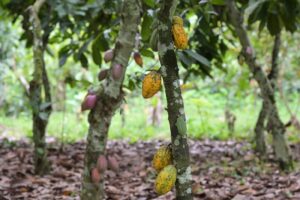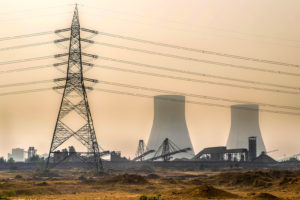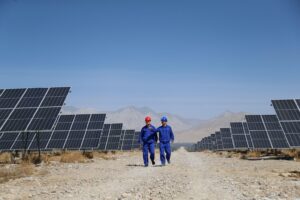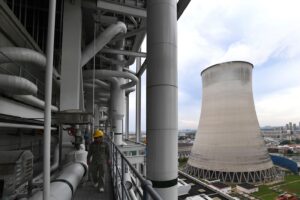Record numbers of delegates have been registered for this year’s COP28 climate summit in the United Arab Emirates (UAE), making it potentially the largest in COP history by some distance.
More than 80,000 participants have badges for this year’s Conference of the Parties (COP) in Dubai.
This is 30,000 more than travelled to Sharm El-Sheikh in Egypt for COP27 last year, the previous largest in an almost 30-year history of summits.
For the first time in COP history, every single delegate has been named in the participant lists.
Previous COPs have typically seen thousands of “overflow” participants in which countries and UN agencies could nominate delegates without their names appearing on their official lists.
Also named this year are “host country guests” – those receiving badges as guests of the UAE.
Recipients include former UK prime ministers Boris Johnson and Tony Blair, Microsoft co-founder Bill Gates, CEO and chairman of French energy giant EDF Luc Rémont and NATO secretary general Jens Stoltenberg.
This year, 3,000 “virtual” participants are also named, which takes the overall provisional delegate total for COP28 to around 84,000.
Unsurprisingly, the UAE has the largest-ever registered delegation of any country, with 4,409 badges. This is followed by Brazil with 3,081 and then China and Nigeria, who both have issued 1,411 badges.
Record numbers
For the first time in COP history, the participant lists have been published by the United Nations Framework Convention on Climate Change (UNFCCC) in spreadsheet format, rather than as pdf documents.
The provisional total for COP28 suggests that 81,027 delegates have registered to attend the summit in person. With a further 3,074 attending virtually, this takes the overall total to 84,101.
As the chart below shows, this comfortably makes the Dubai event the largest COP in history. For comparison, the first climate COP – held in Berlin in 1995 – had 3,969 delegates.
Last year’s COP in Sharm El-Sheikh received almost 50,000 delegates, which put it some distance ahead of the 38,000 that attended COP26 in Glasgow in 2021. It highlights a trend of increasing participation at climate COPs following a dip in attendance after the peak of COP21 in Paris in 2015.
It should be noted that these are provisional figures, based on the delegates that have registered for the summit. The UNFCCC will release the final figures – based on participants collecting a physical badge at the venue – after the summit has closed.

Overall totals for delegates from parties, observers and the media for all COPs, as published by the UNFCCC (see this article for more details on the data). Data for COPs 1-27 are the “final” figures, while COP28 data is “provisional”. Chart by Carbon Brief.
As usual, the lists are divided between the different types of groups and organisations attending the summit. The largest group at COP28 is for delegates representing parties. These are nation states, plus the European Union, that have ratified the convention and play a full part in negotiations. This group adds up to 24,488 delegates – more than double the number at COP27 last year.
Unusually, the participant lists for this year also name the “overflow” badges that have been given out. For the UK delegation, examples include 21 members of Prime Minister Rishi Sunak’s press delegation, 16 members of King Charles’s royal household and 18 members of parliament.
For consistency with Carbon Brief’s analysis of previous COPs, the above chart includes this group separately, but the participant lists this year do divide the overflow delegates between groups. Including the overflow numbers takes the total for party representatives to 51,695 – by itself, more than the total number of delegates at any previous COP.
As at COP27, there are no longer any “observer” states now that the Holy See – the government of the Roman Catholic Church, which operates from Vatican City State and is led by the pope as the bishop of Rome – has become a full party to the Convention.
The next-largest group is that of observers from non-governmental organisations (NGOs), which totals 14,338 delegates – again, comfortably the largest for this group in COP history.
Along with the NGOs, there are several other groups that fall into the category of “observer organisations” – such as those participants representing UN bodies, intergovernmental organisations, other agencies and business representatives. These total 3,623 registered delegates – or 4,754 when overflow badges are included.
Finally, another record-breaking group is the number of media delegates – clocking in at 3,972. This total potentially tops the 3,712 media representatives at COP3 in Kyoto in 1997.
UAE largest delegation
The UAE has registered the largest delegation of any party, totalling 4,409 participants – including overflow badges. Even without overflow badges – which hugely swell delegation size – UAE’s group of 620 would be its largest in COP history.
The UAE’s registered delegation at COP27 last year was potentially larger at 1,073 people, but just 436 attended, according to the final lists, putting it second-largest behind Brazil’s delegation of 467.
Brazil has again registered a large delegation for this year’s COP – 3,081 participants including overflow badges – meaning it is only behind UAE for overall delegation size.
Other delegations surpassing 1,000 include China and Nigeria who have both registered 1,411 people, followed by Indonesia with 1,229, Japan 1,067 and Turkey with 1,045.
(It is worth noting that some countries allocate some of their party badges to NGOs, which can artificially inflate the size of their official delegation.)
At the other end of the scale, the smallest delegations have been registered by North Korea (two), Nicaragua (six), Eritrea (seven) and Liechtenstein and Moldova (both eight).
For the third year in a row, both Afghanistan and Myanmar have not registered a delegation to the COP, while San Marino is also not present on the provisional lists this year.
The map and chart below present the delegation size – split between party and overflow badges – for all the countries registered for COP27. The darker the shading, the more delegates that country has signed up. Mouse over the countries to see the number of delegates and the population size.
Gender balance
Along with the names in the participant lists, the UNFCCC also typically provides a title – such as Mr, Ms, Sr or Sra – for each registered participant. In the past, this has allowed Carbon Brief to work out the balance of men to women in the delegations that each country has sent to a COP.
(This analysis always carries the caveat that the titles are designated by UNFCCC and not by Carbon Brief. In addition, Carbon Brief recognises that gender is not best categorised using a binary “male” or “female” label and appreciates that the UNFCCC’s lists may not be wholly accurate.)
However, this year’s lists are slightly different. First, there are a number of participants – particularly, for no obvious reason, in the Canadian delegation – that have not been given a title at all. And other titles that do not indicate gender – such as Dr, Prof, Ambassador and Honourable – have also been used frequently.
Therefore, for this COP28 analysis, these non-gendered titles – which make up around 330 names of more than 24,000 in the list of party delegates – have been excluded.
This gives an average gender balance of party delegations of 62% male to 38% female. The chart below shows how this compares with previous COPs – note that, for consistency, the COP28 figure only includes those on party badges, not overflow ones.
There is just one all-male party delegation this year, which is the two-strong group representing North Korea.

The average size of named party delegations (not including overflows) for each COP, divided by male (orange) and female (purple) participants. The lines show what percentage of the average delegation is male (orange) and female (purple). Data for COPs 1-27 collated from “final” participant lists published by the UNFCCC, while COP28 data is based on the “provisional” list. Note that around 330 delegates in the COP28 provisional list are not included because there is no information on their gender. Chart by Carbon Brief.
The full list of COP28 party delegation sizes can be found here.
The post Analysis: Which countries have sent the most delegates to COP28? appeared first on Carbon Brief.
Analysis: Which countries have sent the most delegates to COP28?
Climate Change
Q&A: The role of soil health in food security and tackling climate change
Feeding the 8.2 billion people who inhabit the planet depends on healthy soils.
Yet, soil health has been declining over the years, with more than one-third of the world’s agricultural land now described by scientists as “degraded”.
Furthermore, the world’s soils have lost 133bn tonnes of carbon since the advent of agriculture around 12,000 years ago, with crop production and cattle grazing responsible in equal part.
As a result, since the early 1980s, some farmers have been implementing a range of practices aimed at improving soil fertility, soil structure and soil health to address this degradation.
Soil health is increasingly on the international agenda, with commitments made by various countries within the Global Biodiversity Framework, plus a declaration at COP28.
Yet, there is still a lack of knowledge about the state of soils, especially in developing countries.
Below, Carbon Brief explains the state of soil health across the world’s farmlands, the factors that lead to soil degradation and the potential solutions to regenerate agricultural soils.
- What is soil health?
- Why are agricultural soils being degraded?
- Why is soil health important for food security and climate mitigation?
- How can CO2 removal techniques improve soil carbon?
- How can agricultural soil be regenerated?
- What international policies promote soil health?
What is soil health?
Agricultural soil is composed of four layers, known as soil horizons. These layers contain varying quantities of minerals, organic matter, living organisms, air and water.
The upper layers of soil are rich in organic matter and soil organisms. This is where crops and plants thrive and where their roots can be found.
Below the topsoil is the subsoil, which is more stable and accumulates minerals such as clay due to the action of rain, which washes down these materials from the topsoil to deeper layers of the soil.
The subsoil often contains the roots of larger trees. The deeper layers include the substrate and bedrock, which consist of sediments and rocks and contain no organic matter or biological activity.
Soil organic matter consists of the remains of plants, animals and microbes. It supports the soil’s ability to capture water and prompts the growth of soil microorganisms, such as bacteria and fungi, says Dr Helena Cotler Ávalos, an agronomic engineer at the Geospatial Information Science Research Center in Mexico.
Some of these organisms can help roots find nutrients, even over long distances, while others transform nutrients into forms that plants can use. Cotler Ávalos tells Carbon Brief:
“Life in the soil always starts by introducing organic matter.”
Soil is typically classified into three types – clay, silt and sand – based on the size and density of the soil’s constituent parts, as well as the mineral composition of the soil. Porous, loamy soils – a combination of clay, silt and sand – are considered the most fertile type of soil. The mineral composition also influences the properties of the soil, such as colour.
Healthy soils contain three macronutrients – nitrogen, phosphorus and potassium – alongside a range of micronutrients. They also contain phytochemicals, which have antioxidant and anti-inflammatory properties and are important for human health.
Below is a graphic showing the elements that constitute healthy soils, including non-mineral elements such as hydrogen, carbon and oxygen (shown in green), according to the Nature Education Knowledge Project.

The concept of “soil health” recognises the role of soil not only in the production of biomass or food, but also in global ecosystems and human health. The Intergovernmental Technical Panel on Soils – a group of experts that provides scientific and technical advice on soil issues to the Global Soil Partnership at the UN Food and Agriculture Organization (FAO) – defines it as the “ability of the soil to sustain the productivity, diversity and environmental services of terrestrial ecosystems”.
Soils can sequester carbon when plants convert CO2 into organic compounds through photosynthesis, or when organic matter, such as dead plants or microorganisms, accumulate in the soil. Soils also provide other ecosystem services, such as improving air and water quality and contributing to biodiversity conservation.
Why are agricultural soils being degraded?
The term “soil degradation” means a decline in soil health, which reduces its ability to provide ecosystem services.
Currently, about 35% of the world’s agricultural land – approximately 1.66bn hectares – is degraded, according to the FAO.
Introduced during the Industrial Revolution, modern-era industrialised agriculture has spread to dominate food production in the US, Europe, China, Russia and beyond.
Modern modes of industrial agriculture employ farming practices that can be harmful to the soil. Examples include monocropping, where a single crop is grown repeatedly, over-tilling, where the soil is ploughed excessively, and the use of heavy machinery, pesticides and synthetic fertilisers.
Agricultural soils are also degraded by overgrazing, deforestation, contamination and erosion.
The diagram below depicts the different types of soil degradation: physical, chemical, biological and desertification.
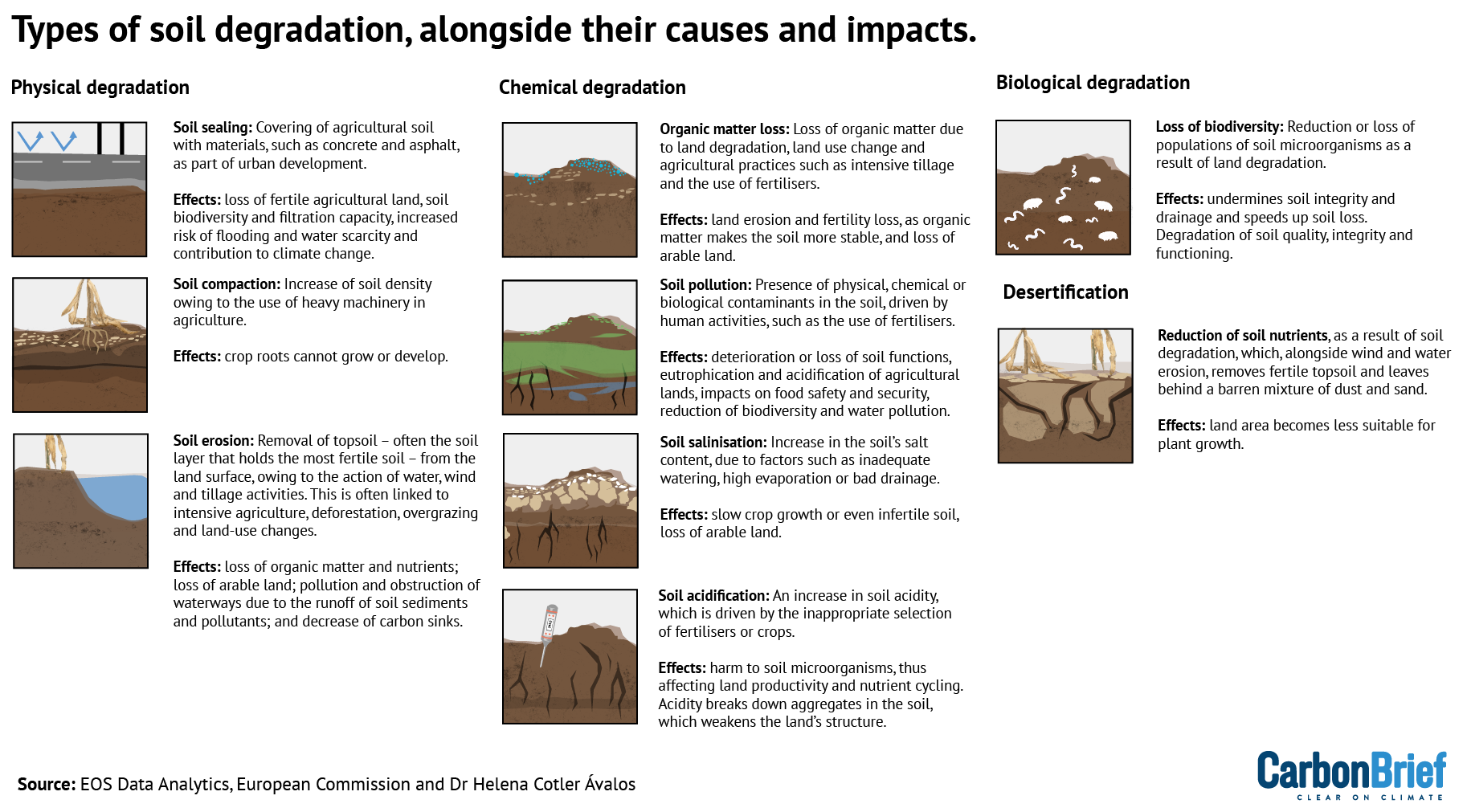
Types of soil degradation, alongside their causes and impacts. Source: EOS Data Analytics, European Commission and Dr Helena Cotler Ávalos. Credit: Kerry Cleaver for Carbon Brief.
Industrial agriculture is responsible for 22% of global greenhouse gas emissions and also contributes to water pollution and biodiversity loss.
The map below, from the FAO, shows the state of land degradation around the world, from “strong” (dark red) to “stable or improv[ing]” (bright green).
It shows that the most degraded agricultural lands are in the southern US, eastern Brazil and Argentina, the Middle East, northern India and China.
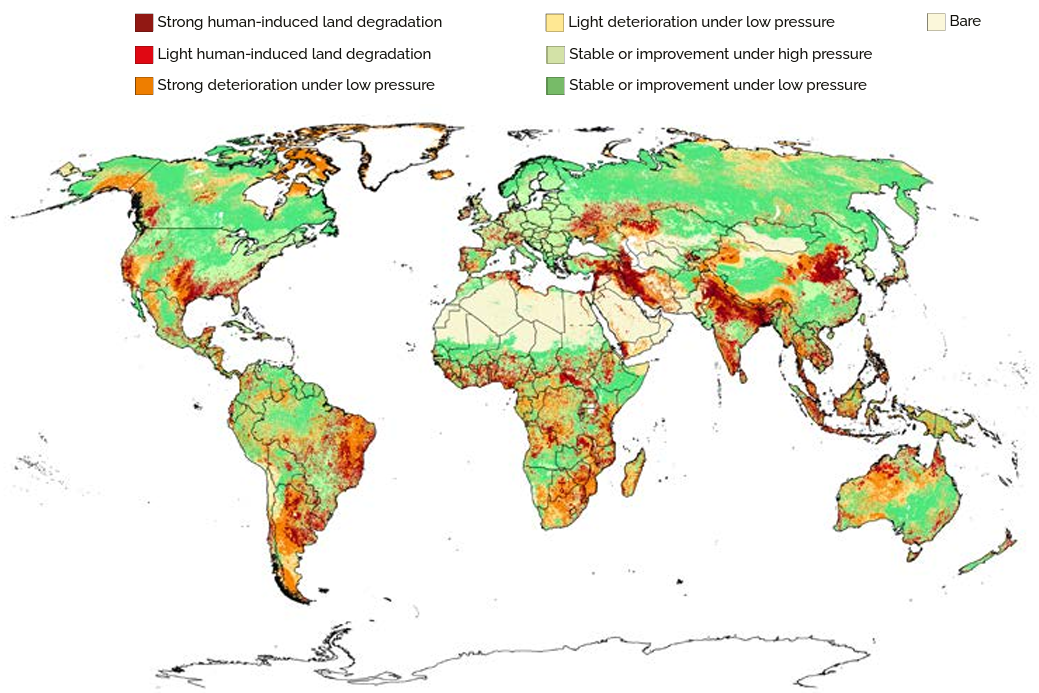
Soil degradation became widespread following the Green Revolution in the 1940s, says Cotler Ávalos. During the Green Revolution, many countries replaced their traditional, diversified farming systems with monocultures. The Green Revolution also promoted the use of synthetic fertilisers and pesticides.
These changes led to a “dramatic increase” in yields, but also resulted in disrupting the interactions between microorganisms in the soil.
Cotler Ávalos tells Carbon Brief:
“It is the microorganisms that give life to soils. They require organic matter, which has been replaced by [synthetic] fertilisers.”
Today, there is a widespread lack of data on the condition of soils in developing countries.
For example, in sub-Saharan Africa, there are few studies measuring the rate and extent of soil degradation due to insufficient, reliable data. In Latin America, data on soil carbon dynamics are scarce.
Conversely, the EU released a report in 2024 about the state of its soils, spanning various indicators of degradation, including pollution, compaction and biodiversity change. The report estimates that 61% of agricultural soils in the EU are “degraded”, as measured by changes in organic carbon content, soil biodiversity and erosion levels.
The UK also has its own agricultural land classification maps, which classifies the condition of agricultural soils into categories ranging from “excellent” to “very poor”. This year, a report found that 40% of UK agricultural soils are degraded due to intensive agriculture.
Cotler Ávalos tells Carbon Brief:
“No country in the global south has data on how much of its soil is contaminated by agrochemicals, how much is compacted by the use of intensive machinery, how much has lost fertility due to the failure to incorporate organic matter.
“What is not studied, what is not known, seems to be unimportant. The problem of soil erosion is a social and political problem, not a technical one.”
Improved soil data, indicators and maps can help guide the sustainable management and regeneration of agricultural soils, experts tell Carbon Brief.
Why is soil health important for food security and climate mitigation?
As around 95% of the food the world consumes is produced, directly or indirectly, on soil, its health is crucial to global food security.
Food production needs to satisfy the demand of the global population, which is currently 8.2 billion and is expected to surpass 9 billion by 2037.
A 2023 review study pointed out that the total area of global arable land is estimated at 30m square kilometres, or 24% of the total land surface. Approximately half of that area is currently cultivated.
Studies have estimated that soil degradation has reduced food production by between 13% and 23%.
The 2023 review study also projected that land degradation could cut global food production by 12% in the next 25 years, increasing food prices by 30%.
Another recent study found that, between 2000 and 2016, healthy soils were associated with higher yields of rainfed corn in the US, even under drought conditions.
Research shows that soil health plays an important role in nutrition.
For example, a 2022 study found that a deficiency in plant nutrients in rice paddy soils in India is correlated with malnutrition. The country faces a growing amount of degraded land – currently spanning 29% of the total geographical area – and more than 15% of children are reported to suffer from deficiencies in vitamins A, B12 and D, along with folate and zinc, according to the study.
Soil health is also crucial for mitigating climate change.
Global agricultural lands store around 47bn tonnes of carbon, with trees contributing 75% of this total, according to a 2022 study.
Agricultural soils could sequester up to 4% of global greenhouse gas emissions annually and make a “significant contribution to reaching the Paris Agreement’s emissions reduction objectives”, according to a report from the Organisation for Economic Co-operation and Development (OECD).
Some farming practices can reduce greenhouse gas emissions and improve soil carbon sequestration, such as improving cropland and grazing land management, restoring degraded lands and cultivating perennial crops or “cover crops” that help reduce erosion.
However, some scientists have warned that the amount of carbon that can be captured in global soils – and how long that carbon remains locked away – has been overestimated.
For example, an article published in Science in 2023 argued that one of the widely used models for simulating the flow of carbon and nitrogen in soils, known as DayCent, has “plenty of shortcomings”. It says:
“It doesn’t explicitly represent how soils actually work, with billions of microbes feasting on plant carbon and respiring much of it back to the atmosphere – while converting some of it to mineralised forms that can stick around for centuries.
“Instead, the model estimates soil carbon gains and losses based on parameters tuned using published experimental results.”
That, along with uncertainties associated with small-scale estimations, makes the model unable to accurately predict increases or decreases of soil carbon over time and, thus, a positive or negative impact on the climate, the outlet said.
How can CO2 removal techniques improve soil carbon?
Soils can also play a role in mitigating climate change through the use of CO2 removal techniques, such as biochar and enhanced rock weathering.
Biochar is a carbon-rich material derived from the burning of organic matter, such as wood or crop residues, in an oxygen-free environment – a process known as pyrolysis.
Biochar can be added to soils to enhance soil health and agricultural productivity.
Due to its porous nature, biochar holds nutrients in the soil, improving soil fertility, water retention, microbial activity and soil structure.
The long-term application of biochar can bring a range of benefits, such as improving yields, reducing methane emissions and increasing soil organic carbon, according to recent research that analysed 438 studies from global croplands.
However, the study added that many factors – including soil properties, climate and management practices – influence the magnitude of these effects.

Dr Dinesh Panday, a soil scientist at the agricultural research not-for-profit Rodale Institute and an expert in biochar, tells Carbon Brief that biochar typically is applied when soils have low carbon or organic matter content.
He adds that this technique is currently being used mostly in growing high-value crops, such as tomatoes, lettuce and peppers. For staple crops, including rice, wheat and maize, the use of biochar is only at a research stage, he adds.
Enhanced rock weathering is a process where silicate rocks are crushed and added to soils. The rocks then react with CO2 in the atmosphere and produce carbonate minerals, storing carbon from the atmosphere in the soil.
In the US, enhanced weathering could potentially sequester between 0.16-0.30bn tonnes of CO2 per year by 2050, according to a 2025 study.
Panday says that both biochar and enhanced weathering are mostly practised in developed countries at the moment and both have their own benefits and impacts. One of the disadvantages of biochar, he says, is its high cost, as producing it requires dedicated pyrolysis devices and the use of fossil gas. One negative effect of enhanced rock weathering is that it may alter nutrient cycling processes in the soil.
A 2023 comment piece by researchers from the University of Science and Technology of China raised some criticisms of biochar application, including the resulting emissions of methane and nitrous oxide, the enrichment of organic contaminants and heavy metals, and the dispersion of small particulate matter that can be harmful to human health.
Scientists still question how much carbon-removal techniques, such as enhanced rock weathering, can store in agricultural soils and for how long.
How can agricultural soil be regenerated?
Many types of farming practices can help conserve soil health and fertility.
These practices include minimising external inputs, such as fertilisers and pesticides, reducing tillage, rotating crops, using mixed cropping-livestock farming systems, applying manure or compost and planting perennial crops.
Low- or no-till practices involve stopping the large-scale turning over of soils. Instead, farmers using these systems plant seeds through direct drilling techniques, which helps maintain soil biodiversity. A 2021 review study found that in the south-eastern US, reducing tillage enhanced soil health by improving soil organic carbon, nitrogen and inorganic nutrients.
Mixed farming systems, which integrate the cultivation of crops with livestock, have also been found to be beneficial to soil health.
A 2022 study compared a conventional maize-soya bean rotation and a diverse four-year cropping system of maize, soya bean, oat and alfalfa in the mid-western US. It found that, compared to the conventional farm, the diversified system had a 62% increase in soil microbial biomass and a 157% increase in soil carbon.
One of the aims of soil regeneration is to make agricultural soil as much like a natural soil as possible, says Dr Jim Harris, professor of environmental technology at the Cranfield Environment Centre in the UK.
Harris, who is an expert in soil and ecological restoration, says that regenerating soils involves restoring the ecological processes that were once replaced by chemical inputs, while maintaining the soil’s ability to grow crops.
For example, he says, using regenerative agricultural approaches, such as rotational grazing, can help increase soil organic matter and fungi populations.
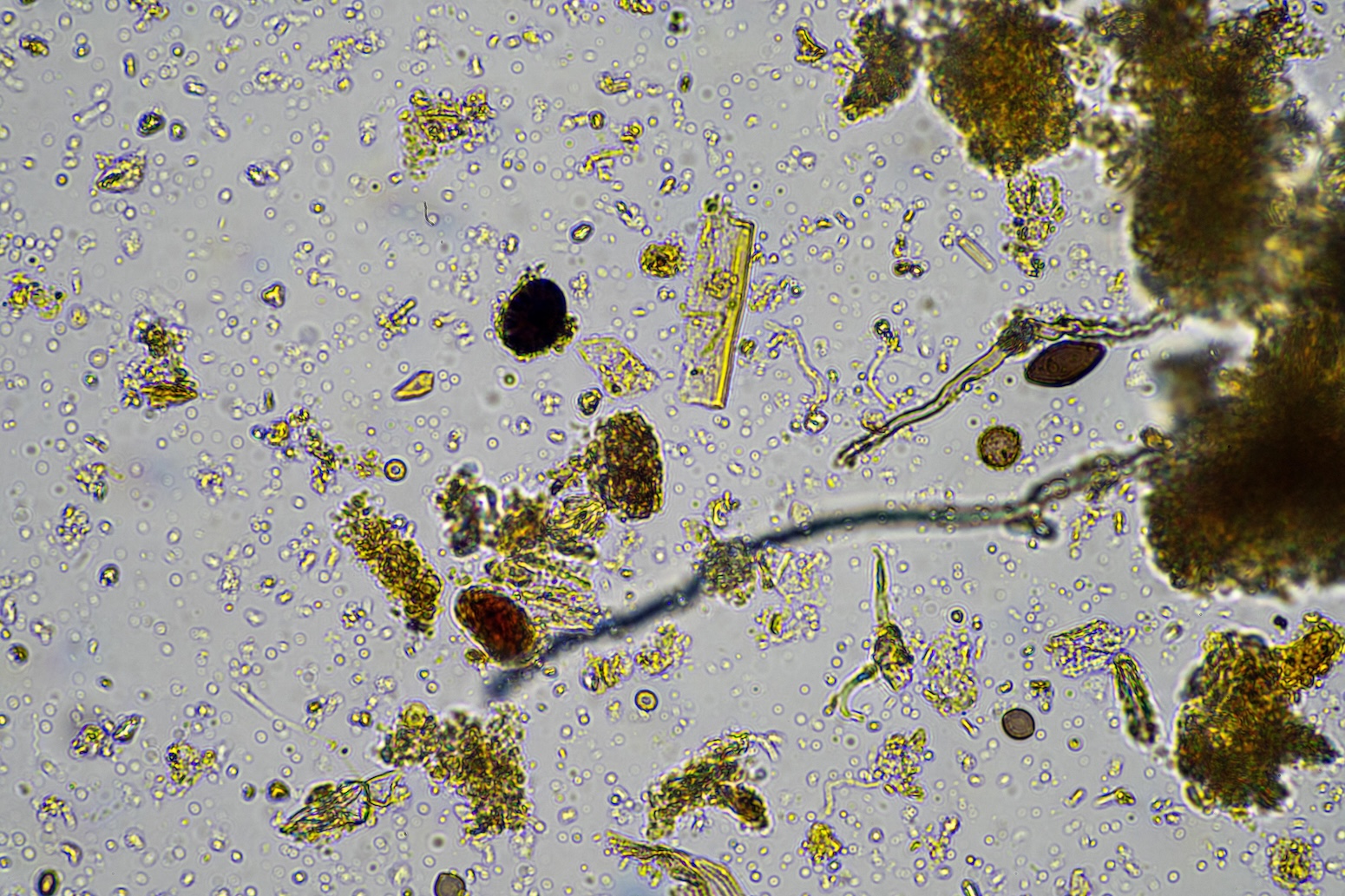
Which soil regeneration actions will be most successful will depend on the soil type, the natural climatic zone in which a farm is located, the rainfall and temperature regimes and which crops are being cultivated, he adds.
To measure the results of soil regeneration, farmers need to establish a baseline by determining the initial condition of the soil, then assess indicators of soil health. These indicators range from physical indicators, such as root depth, to biological indicators, such as earthworm abundance and microbial biomass.
In Sweden, researchers analysed these indicators in 11 farms that applied regenerative practices either recently or over the past 30 years. They found that the farms with no tillage, integration of livestock and organic matter permanent cover had higher levels of vegetation density and root abundance. Such practices had positive impacts on soil health, according to the researchers.
Switching from conventional to regenerative agriculture may take a farmer five to 10 years, Harris says. This is because finding the variants of a crop that are most resistant to, say, drought and pests could take a “long time”, but, ultimately, farms will have “more stable yields”, he says.
Harris tells Carbon Brief:
“Where governments can really help [is] in providing farmers with funds that allow them to make that transition over a longer period of time.”
Research has found that transitioning towards regenerative agriculture has economic benefits for farmers.
For example, farmers in the northern US who used regenerative agriculture for maize cropping had “29% lower grain production, but 78% higher profits over traditional corn production systems”, according to a 2018 study. (The profit from regenerative farms is due to low seed and fertiliser consumption and higher income generated by grains and other products produced in regenerative corn fields, compared to farms that only grow corn conventionally.)
A 2022 review study found that regenerative farming practices applied in 10 temperate countries over a 15-year period increased soil organic carbon without reducing yields during that time.
Meanwhile, a 2024 study analysing 20 crop systems in North America found that maize and soya bean yields increased as the crop system diversified and rotated. For example, maize income rose by $200 per hectare in sites where rotation included annual crops, such as wheat and barley. Under the same conditions, soya bean income increased by $128 per hectare, the study found.
The study pointed out that crop rotation – one of the characteristics of regenerative agriculture – contributes to higher yields, thanks to the variety of crops with different traits that allow them to cope with different stressors, such as drought or pests.
However, other research has questioned whether regenerative soil practices can have benefits for both climate mitigation and crop production.
A 2025 study modelled greenhouse gas emissions and yields in crops through to the end of the century. It found that grass cover crops with no tillage reduced 32.6bn tonnes of CO2-equivalent emissions by 2050, but reduced crop yields by 4.8bn tonnes. The lowest production losses were associated with “modest” mitigation benefits, with just 4.4bn tonnes of CO2e emissions reduced, the study added.
The authors explained that the mitigation potential of cover crops and no tillage was lower than previous studies that overlooked certain factors, such as soil nitrous oxide, future climate change and yields. Moreover, they warned, carbon removal using regenerative farming methods risks the release of emissions back into the atmosphere, if soil management returns to unsustainable practices.
Several of the world’s largest agricultural companies, including General Mills, Cargill, Unilever, Mars and Mondelez, have committed to regenerative agriculture goals. Nestlé, for example, has said that it is implementing regenerative agriculture practices in its supply chain that have had “promising initial results”. It adds that “farmers, in many cases, stand to see an increase in crop yields and profits”. As a result, the firm says it is committed to sourcing 50% of its ingredients from farms implementing regenerative agriculture by 2030.
However, Trellis, a sustainability-focused organisation, cautioned that “these results should be taken somewhat sceptical[ly]”, as there is no set definition on what regenerative agriculture is and measurement of the results is “lacking”.
In some places, the regeneration or recovery of agricultural soils is still practised alongside farmers’ traditional knowledge.
Ricardo Romero is an agronomist and the managing director of the cooperative Las Cañadas – Cloud Forest, lying 1300m above sea level in Mexico’s Veracruz mountains. There, cloud forests sit between tropical rainforest and pine forests, in what Romero considers “a very small ecosystem globally”, optimal for coffee plantations.
His cooperative is located on land previously used for industrial cattle farming. Today, the land is used for agroecological production of coffee, agroforestry and reforestation. The workers in the cooperative are mostly peasants who take on production and use techniques to improve soil fertility that they have learned by doing.

Romero says the soils in his cooperative have improved and crop yields have been maintained thanks to the compost they produce. He tells Carbon Brief:
“We are still in the learning stage. We sort of aspire to achieve what cultures such as the Chinese, Koreans and Japanese did. They returned all their waste to the fields and their agriculture lasted 4,000 years without chemical or organic fertilisers”.
What international policies promote soil health?
Soil health and soil regeneration feature in four of the targets under the UN Sustainable Development Goals (SDGs).
(There are 169 targets under the SDGs that contain measurable indicators for assessing progress towards each of the 17 goals.)
For example, target 15.3 calls on countries to “restore degraded land and soil” and “strive to achieve a land-degradation neutral world”.
Soil health is increasingly being recognised in international negotiations under the UN Framework Convention on Climate Change (UNFCCC), UN Convention on Biological Diversity (UN CBD) and the UN Convention to Combat Desertification (UNCCD), says Katie McCoshan, senior partnerships and international engagement manager for the Food and Land Use Coalition (FOLU).
Each of these conventions has established its own work groups, declarations and frameworks around soil health in recent years.
Ideally, says McCoshan, action on soils should be integrated across the three different conventions, as well as in conversations around food and nutrition.
However, work across the three conventions remains siloed.
Currently, agriculture is formally addressed under the UNFCCC via the Sharm el-Sheikh joint work on implementation of climate action on agriculture and food security, a four-year work plan agreed at COP27 in 2022. This work group is meant to provide countries with technical support and facilitate collaboration and research.
The COP27 decision that created the Sharm el-Sheikh agriculture programme “recognised that soil and nutrient management practices and the optimal use of nutrients…lie at the core of climate-resilient, sustainable food production systems and can contribute to global food security”.
At COP28 in Dubai, the presidency announced the Emirates Declaration on Sustainable Agriculture, Resilient Food Systems and Climate Action. The 160 countries that signed the declaration committed to integrating agriculture and food systems into their nationally determined contributions, national adaptation plans and national biodiversity strategies and action plans (NBSAPs). The declaration also aims to enhance soil health, conserve and restore land.
Harris says the Emirates Declaration is a “great first step”, but adds that it will “take time to develop the precise on-the-ground mechanisms” to implement such policies in all countries, as “they are moving at different speeds”.
Within the UNFCCC process, soil has also featured in non-binding initiatives such as the 4 per 1000, adopted at COP21 in Paris. The initiative aims to increase the amount of carbon sequestered in the top 30-40cm of global agricultural soils by 0.4%, or four parts per thousand, per year.
The UNCCD COP16, which took place in 2024 in Saudi Arabia, delivered a decision to “encourage” countries to avoid, reduce and reverse soil degradation of agricultural lands and improve soil health.
Although COP16 did not deliver a legally binding framework to combat drought, it resulted in the creation of the Riyadh Global Drought Resilience Partnership, a global initiative integrated by countries, international organisations and other countries to allocate $12bn towards initiatives to restore degraded land and enhance resilience against drought.
The COP also resulted in the Riyadh Action Agenda, which aspires to conserve and restore 1.5bn hectares of degraded land globally by 2030.
Although soil health appears under both conventions, it is not included as formally in the UNFCCC as in the UNCCD – as in the latter there is a direct mandate for countries to address soil health and land restoration, McCoshan tells Carbon Brief.
Under the UNCCD, countries have to establish land degradation neutrality (LDN) targets by 2030. To date, more than 100 countries have set these targets.
Under the biodiversity convention, COP15 held in Montreal in 2022 delivered the Kunming-Montreal Global Biodiversity Framework (GBF), a set of goals and targets aiming to “halt and reverse” biodiversity loss by 2030. Under the framework, targets 10 and 11 reference sustainable management of agriculture through agroecological practices, and the conservation and restoration of soil health, respectively.
A recent study suggests that restoring 50% of global degraded croplands could avoid the emission of more than 20bn tonnes of CO2 equivalent by 2050, which would be comparable to five times the annual emissions from the land-use sector. It would also bring biodiversity benefits and contribute to target 10 of the GBF and to UNCCD COP16 recommendations, the study added.
McCoshan tells Carbon Brief:
“[All] the pledges are important and they hold countries accountable, but that alone isn’t what we need. We’ve got to get the financing right and co-create solutions with farmers, Indigenous people, youth, businesses and civil society as well.”
The post Q&A: The role of soil health in food security and tackling climate change appeared first on Carbon Brief.
Q&A: The role of soil health in food security and tackling climate change
Climate Change
Q&A: How ‘vehicle-to-grid’ technology could boost China’s electricity system
China’s surging electric vehicles (EVs) ownership – now exceeding 25.5m – is opening the door to a new technology that can help to enhance the flexibility of electricity supply.
EVs connected via “vehicle-to-grid” (V2G) technology can function as “batteries on wheels” that charge and discharge according to the needs of the wider electricity system.
The idea of turning EVs into “power banks” has already sparked both business and political interest in China.
How can V2G help balance the grid?
V2G involves two-way electric charging that allows EVs to act as flexible power sources, which can potentially help with the electricity supply from the grid.
In China, EVs with bidirectional batteries, when plugged into V2G-capable charging stations, are able to sell their stored electricity back to the grid, once owners complete registration on WeChat.
The country is currently trialling the technology in nine “pilot cities”, including Shanghai, as well as Guangzhou and Shenzhen, where EV operators are able to sell electricity to the grid, according to a V2G policy announced in April.
The policy is the world’s first nationwide pilot that aims to roll out V2G at scale in major cities. Payments – either in cash or coupons – are provided to EV owners to offset their charging costs in industrial parks, ports, as well as malls and residential compounds.
This is, however, not the first top-level policy framework for V2G in China. In late 2023, the National Reform and Development Commission (NDRC) pledged to establish a system of V2G technical standards by 2025 and to test its potential.
Dr Muyi Yang, senior electricity analyst at thinktank Ember, tells Carbon Brief that the April policy sends a “signal that China’s energy transition is entering a deeper phase”.
He adds that this new policy marks a major step in integrating EVs with the power grid, considering that China is rapidly enlarging its renewable capacity. However, the country’s current grid system sometimes struggles to take in all of the electricity being generated.
“China’s wind and solar capacity is becoming too large for the current grid to handle,” Yang tells Carbon Brief. “With their [combined] capacity now exceeding that of coal power, the grid flexibility has become increasingly insufficient.”
A fleet of grid-connected EVs could help China achieve its broader plan to restructure its power sector towards a “new power system” that aims to be more flexible and responsive to power volatility, says Yang.
Equipped with V2G, EVs could charge up their batteries or sell stored electricity according to owners’ preferences and the overall needs of the power system.
This provides the means and potential for the grid to integrate renewable energy more flexibly, says Zhou Xiaohang, China clean-power project manager at the US-registered Natural Resource Defense Council in Beijing.
She tells Carbon Brief that, in the long run, V2G can help to address the curtailment issue for renewable energy, which is often referred to as the “Xiaona” problem in China.
What is the current state of V2G adoption?
Currently, V2G has not been widely deployed in China. The cost of V2G infrastructure installation remains high.
Zhou says the success of large-scale roll out of V2G depends on whether there are enough EVs equipped with the bidirectional batteries and able to be plugged into V2G-capable charging stations.
Data company China Automotive Technology and Research Centre says that the share of new car sales made up by “new-energy vehicles” (NEVs) – mostly EVs – is more than 40% in almost all nine pilot cities tapped to develop V2G.
Even though not all EVs support V2G, the large number of EVs on the road suggests strong potential to build it into a profitable commercial model.
Zhou says that since China “already [has] enough EVs on the road to make [V2G] possible”, there are “no major technical barriers to scale up V2G interaction”.
Meanwhile, popular car brands such as BYD and Nio have released new EV models with V2G features and many more are actively testing and preparing for two-way electric charging.
In a June podcast, Anders Hove, senior research fellow at the Oxford Institute for Energy Studies, says carmakers are pushing for faster progress. He explains:
“My understanding is that the Chinese EV and battery makers are communicating with grid companies and power-sector regulators that the technology is now ready. They would like there to be additional regulations to enable this to start happening at scale.”
There are 30 such demonstration projects going on at the moment. The results of those projects will be collected by the NDRC and the National Energy Administration for evaluating future scaleup.
Shenzhen, for example, received more than 70,000 kilowatt hours (kWh) of electricity from about 2,500 EVs in June.
V2G services have the potential to become popular nationwide, says Yang, partly because it could also become a source of income for EV owners and businesses.
According to the Paper, a Shanghai-based news outlet, an EV owner could earn roughly 500 yuan ($70) in electricity charging vouchers by discharging 460kWh in a month.
In Shenzhen, a logistics company with 30 EVs is estimated to save up to 4,500 yuan ($631) a month by joining the V2G programme, says China Automotive News, a state-sponsored media outlet.
What are the challenges in expansion?
Regional governments are working to introduce more profitable pricing systems to boost user participation.
Guangdong province, in south China, has launched a V2G pricing plan that is “appealing” enough for EV owners to see a profit from participating in the scheme, according to Zhou, which will help drive wider adoption.
However, there will need to be a deeper level of power-sector reform for V2G to become fully commercialised, says Shen Xinyi, researcher at Centre for Research on Energy and Clean Air (CREA).
Currently, a large share of China’s electricity is still traded through long-term power contracts, which could limit incentives for individual EV owners to engage in power trading.
Shen tells Carbon Brief:
“Flexible systems like V2G and distributed solar power need a well-developed spot market and experienced, professional players such as power retailers to truly thrive…I think it still needs a lot of patience to see how theory turns into practice.”
It could take years before V2G reaches a significant level of adoption, due to the uncertainty of whether it can be turned into a viable business model, says Shen.
According to Zhou, whether V2G can be rolled out at scale also depends on the attitudes of consumers.
“The key to expanding V2G is getting users motivated and willing to take part,” she says, adding that more work needs to be done to address Chinese consumers’ concerns on battery health and safety issues, including whether frequent discharges could cause battery degradation.
According to the 2023 policy, the lifespan of EV batteries still needs to improve so it can handle frequent use without wearing out too quickly – a concern long noted by the industry.
In April 2024, Hui Dong, chief technical expert at the China Electric Power Research Institute, a research institute affiliated to the State Grid Corporation of China, stated that, in terms of lifespan, chemical energy storage systems, represented by lithium-ion batteries, are still “underperforming”.
The post Q&A: How ‘vehicle-to-grid’ technology could boost China’s electricity system appeared first on Carbon Brief.
Q&A: How ‘vehicle-to-grid’ technology could boost China’s electricity system
Climate Change
Global South’s climate adaptation bill to top $300 billion a year by 2035 – UN
Developing countries will need to spend between $310 billion and $365 billion per year on measures to adapt to climate change impacts by 2035, a UN report showed on Wednesday, warning of a massive funding shortfall as wealthy governments pare back their support.
The latest estimate of developing countries’ annual climate adaptation needs outstrips current funding by at least 12 times, with rich nations providing just $26 billion in 2023, according to the UN Environment Programme’s (UNEP) annual Adaptation Gap Report.
Commenting on the report, UN Secretary-General António Guterres called the funding gap “a failure of global solidarity [which] is measured in flooded homes, failed harvests, derailed development – and lost lives”. “As the climate crisis deepens and costs climb, the world must move much faster to match rising needs,” he added.
The UNEP had previously estimated annual climate adaptation needs at between $215 billion and $387 billion a year by 2030, saying the 2035 estimate was narrower because of better modelling and data on the cost of planned measures to adapt to more extreme weather and rising seas.
Most of the money would be used by developing countries to protect infrastructure, agriculture and healthcare systems, and prevent coasts and rivers from flooding, the report found. The authors added that their estimate was likely conservative because climate-driven disasters such as wildfires and the cost of air-conditioning to deal with heatwaves were excluded from the analysis.
Upper-middle-income countries – a category that includes populous nations like China, Brazil and Mexico – account for about two-thirds of the estimated funding needs. Lower-middle-income and low-income countries will require most of the rest, with a small amount needed for high-income developing countries such as Saudi Arabia and Barbados, the report said.
Global South nations have long pushed in UN climate negotiations for Global North countries that historically bear the greatest responsibility for climate change to give them more money to withstand its effects. At COP26 in Glasgow four years ago, governments agreed to “urge” developed countries to double their adaptation finance between 2019 and 2025.
But UNEP’s report warns that this target “will be missed if current trends continue”. Meeting it would require adaptation finance of at least $40 billion in 2025, but international adaptation finance from donor countries fell from $28 billion in 2022 to $26 billion in 2023, UNEP said. Data on 2024 funding has not yet been released.
In her introduction to the report, UNEP Executive Director Inger Andersen wrote that “many more people will suffer needlessly” if the goal to double climate adaptation financing is missed.
A recent report by development agencies Oxfam and CARE Climate Justice Centre predicted that because of cuts to aid budgets by governments including the US, Britain, Germany and France, adaptation finance will be stuck at $26 billion in 2025, leaving developed countries far short of their goal.
Adaptation high on the agenda at COP30
Adaptation is set to be a key theme of the upcoming COP30 summit in Brazil. Governments will negotiate dozens of indicators to track how well countries are adapting to climate change, as part of the new Global Goal on Adaptation. This could include finance targets – although developed countries have resisted this.
The world’s poorest nations – known as the Least-Developed Countries (LDCs) – are leading a push for a new goal to triple adaptation finance by 2030 to about $100 billion a year. Announcing this push at the mid-year climate talks in June, LDC chair Evans Njewa said “adaptation is a lifeline”, adding that he expected other developing countries to join their call for a new, higher goal.
Climate adaptation can’t be just for the rich, COP30 president says
Speaking a day after Hurricane Melissa devastated Jamaica, Guterres called on the private sector to “step up” and invest far more in resilience and adaptation. The report said the private sector can invest in adaptation through measures such as installing air-conditioning in factories and mechanising outdoor work.
Guterres added that multilateral development banks should “mobilise far more private affordable finance and devote half of their climate funding to adaptation”. Most of the lenders spend more on emissions-cutting than adaptation.
Public adaptation finance should also become faster and simpler to access, Guterres said, adding that every person on earth should be protected by an early-warning system for disasters by 2027 – a goal set by the UN in 2022.
“Adaptation is not a cost – it is a lifeline,” he said. “Let us not waste another moment.”
The post Global South’s climate adaptation bill to top $300 billion a year by 2035 – UN appeared first on Climate Home News.
Global South’s climate adaptation bill to top $300 billion a year by 2035 – UN
-
Climate Change2 years ago
Spanish-language misinformation on renewable energy spreads online, report shows
-
Climate Change3 months ago
Guest post: Why China is still building new coal – and when it might stop
-
Climate Change Videos2 years ago
The toxic gas flares fuelling Nigeria’s climate change – BBC News
-

 Greenhouse Gases1 year ago
Greenhouse Gases1 year ago嘉宾来稿:满足中国增长的用电需求 光伏加储能“比新建煤电更实惠”
-
Greenhouse Gases3 months ago
Guest post: Why China is still building new coal – and when it might stop
-

 Climate Change1 year ago
Climate Change1 year ago嘉宾来稿:满足中国增长的用电需求 光伏加储能“比新建煤电更实惠”
-

 Carbon Footprint2 years ago
Carbon Footprint2 years agoUS SEC’s Climate Disclosure Rules Spur Renewed Interest in Carbon Credits
-
Renewable Energy4 months ago
US Grid Strain, Possible Allete Sale








